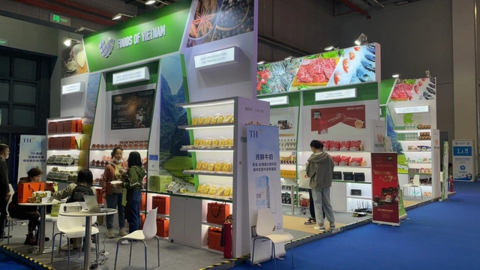
A booth displays Vietnamese foods at an international trade event in China. — Photo MoIT
Nguyen Thi Minh Huyen, deputy head of MoIT's e-commerce and digital economy department, said cross-border trade via the platforms had so far been the fastest and cheapest way to access Chinese consumers.
But she said steps must be taken to ensure the trade's sustainable development.
Huyen's department has been working closely with several e-commerce platforms to connect with partners and consumers in the Chinese market. The focus is on how to best support Vietnamese businesses to link operations with Chinese retailers, brand-building companies and e-commerce firms.
Huyen said feedback from businesses so far had been positive with the vast majority of them getting the hang of how to work with major Chinese e-commerce platforms. Some Vietnamese brands had been successfully marketed and sold widely in China such as Ca phe Sai Gon, Vicosap, Sao Thai Duong cosmetics, Lipo and Tipo snacks.
Nguyen Thi Diem Hang, chairperson of VinaNutriFood, who has been in charge of a Vietnamese national store on JD, one of the largest e-commerce sites in China, said her company had just finished setting up an office in China and officially launched the store on JD.com, a cross-border e-commerce platform that enables Chinese customers to purchase products from other countries.
She said it had taken a lot longer than previously anticipated due to China's strict social distancing measures, which had just been removed.
According to the ministry, more than 300 Vietnamese businesses have registered their products under the national store on JD.com but so far the store will only approve those that are qualified under Chinese regulations.
Hang said: "The Chinese market has certain standards, on par with the EU and US markets, which demand Vietnamese businesses to improve on safety, quality and packaging," she said, adding it would likely take some time for businesses to catch up.
"Preparing and getting things right on our first attempt is very important. It may take a bit longer but we do not want negative feedback from Chinese consumers, which may result in many Vietnamese brands getting blacklisted in the market."
Huyen added that businesses must take time to learn more about Chinese consumers and the best approach is to partner with Chinese companies that also operate on the same e-commerce platforms.
"We should seek out partners with experience in dealing with Chinese consumers and established customer bases to ensure a smooth introduction of Vietnamese products into the market," she said. — VNS